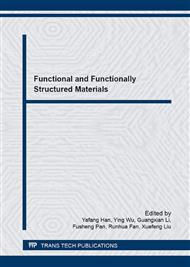[1]
Roger C.L. Feneley, Calvin M. Kunin, David J. Stickler, An indwelling urinary catheter for the 21st century, BJU International. 109 (2012) 1746-1749.
DOI: 10.1111/j.1464-410x.2011.10753.x
Google Scholar
[2]
D. Pavithra, M. Doble, Biofilm formation, bacterial adhesion and host response on polymeric implants-issues and prevention, Biomed Mater. 3 (2008) 034003.
DOI: 10.1088/1748-6041/3/3/034003
Google Scholar
[3]
Shertetz RJ, Forman DM, Solomon DD, Efficacy of dicloxacillin-coated polyurethane cathers in preventing subcutaneous Staphylococcus aureus infections in mice, Antimicrobial Agents and Chemotherapy. 33 (1989) 1174-1178.
DOI: 10.1128/aac.33.8.1174
Google Scholar
[4]
Flowers RH, Schwenzer KJ, Kopel RF, Fisch MJ, Tucker SI, Farr BM, Efficacy of an attachable subcutaneous cuff for the prevention of intravascular catheter-related infection: a randomized, controlled trial, JAMA. 261 (1989) 878-883.
DOI: 10.1097/00132586-198910000-00056
Google Scholar
[5]
D.K. Chattopadhyay, K.V.S.N. Raju, Structural engineering of polyurethane coating for high performance application, Prog. Polym. Sci. 32 (2007) 352–418.
Google Scholar
[6]
Z.K. Bai, W. L Xu, J. Xu, H.J. Yang, S.L. Xiao, X. Liu, G.J. Liang, L.B. Chen, Fabrication and characterization of silk fibroin power/polyurethane fibrous membrane, Polymer Engineering & Science. 52 (2012) 2025-(2032).
DOI: 10.1002/pen.23150
Google Scholar
[7]
F. A. Sheikh, N. A. M. Barakat, M. A. Kanjwe, S. Jeon, H. Kang, H. Kim, Self synthesize of silver nanoparticles in/on polyurethane nanofibers: Nano-biotechnological approach, Journal of applied polymer science. 115 (2010) 3189-3198.
DOI: 10.1002/app.31418
Google Scholar
[8]
V.K. Sharma, R.A. Yngard, Y. Lin, Silver nanoparticles: green synthesis and their antimicrobial activities, Adv Colloid Interface Sci. 145 (2009) 83–96.
DOI: 10.1016/j.cis.2008.09.002
Google Scholar
[9]
W.R. Li, X.B. Xie, Q.S. Shi, H.Y. Zeng, Y.S. Ou-Yang, Y.B. Chen, Antibacterial activity and mechanism of silver nanoparticles on Escherichia coli, Appl Microbiol Biotechnol. 85 (2010) 1115–22.
DOI: 10.1007/s00253-009-2159-5
Google Scholar
[10]
M. Rai, A. Yadav, A. Gade, Silver nanoparticles as a new generation of antimicrobials, Biotechnol Adv. 27 (2009) 76–83.
DOI: 10.1016/j.biotechadv.2008.09.002
Google Scholar
[11]
M.G. Guzma´n, J. Dille, S. Godet, Synthesis of silver nanoparticles by chemical reduction method and their antibacterial activity, Int J Chem Biomol Eng. 2 (2009) 104–11.
Google Scholar
[12]
F. A. Sheikh, N. A. M. Barakat, M. A. Kanjwe, A.A. Chaudhari, I. Jung, J. H. Lee, H. Kang, Electrospun antimicrobial polyurethane nanofibers containing silver nanoparticles for biotechnological applications, Macromolecular Research. 17 (2009).
DOI: 10.1007/bf03218929
Google Scholar
[13]
F. Paladini, M. Pollini, A. Talà, P. Alifano, A. Sannino, Efficacy of silver treated catheters for haemodialysis in preventing bacterial adhesion, Journal of Materials Science: Materials in Medicine. 23 (2012) 1983-(1990).
DOI: 10.1007/s10856-012-4674-7
Google Scholar
[14]
H. Sakabe, H. Ito, T. Miyamoto, Y. Noishiki, W.S. Ha, in vivo blood compatibility of regenerated silk fibroin, Sen'i Gakkaishi. 45 (1989) 487-490.
DOI: 10.2115/fiber.45.11_487
Google Scholar
[15]
X. Fei, M. Jia, X. Du, Y.H. Yang, R. Zhang, Z. Z, Shao, X. Zhao, X. Chen, Green synthesis of silk fibroin-silver nanoparticle composites with effective antibacterial and biofilm-disrupting properties, Biomacromolecules. 14 (2013) 4483-4488.
DOI: 10.1021/bm4014149
Google Scholar
[16]
E. Kharlampieva, D. Zimnitsky, M. Gupta, K. N. Bergman, D. L. Kaplan, R.R. Naik, V. V. Tsukruk, Redox-active ultrathin template of silk fibroin: effect of secondary structure on gold nanoparticle reduction, Chemistry of Materials. 21 (2009).
DOI: 10.1021/cm900073t
Google Scholar
[17]
Z. Chen, X. Hao, D. Wu, J. Rao, F, Shao, The preparation of regenerated silk fibroin protein nanoparticles and antimicrobial properties, Journal of Textile Research. 29 (2008) 17-20.
Google Scholar
[18]
X. Liu, C. Zhang, W. Xu, H. Liu, C. Ouyang, Blend films of silk fibroin and water-insoluble polyurethane prepared from an ionic liquid,Materials Letters. 65(2011) 2489-2491.
DOI: 10.1016/j.matlet.2011.05.017
Google Scholar
[19]
Q. Luo, Z. Chen, X. Hao, Q. Zhu, Y. Zhou, Preparation and properties of nanometer silk fibroin peptide/polyvinyl alcohol blend films for cell growth. International journal of biological macromolecules. 61 (2013) 135-141.
DOI: 10.1016/j.ijbiomac.2013.06.050
Google Scholar


